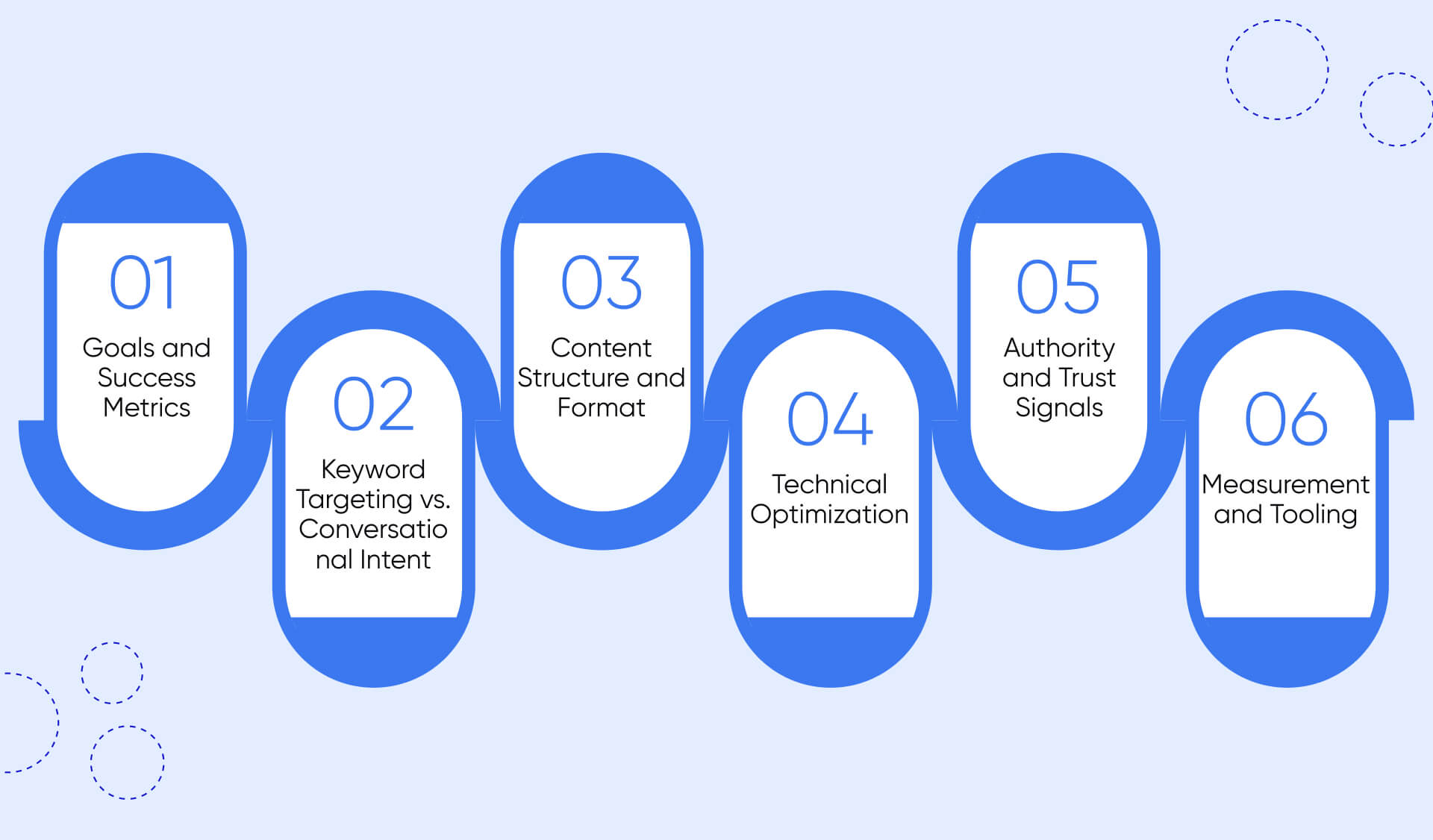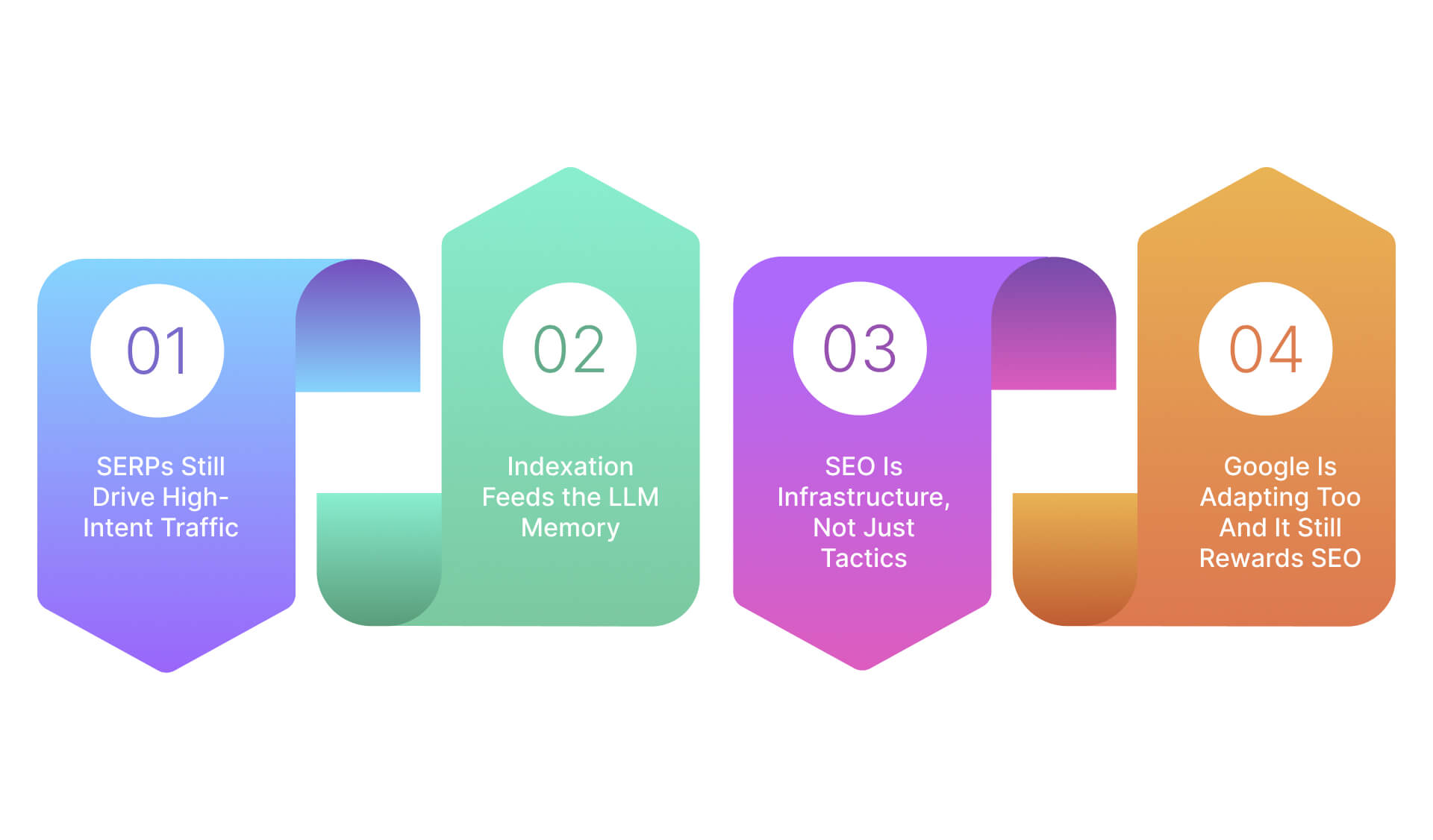What Are the Key Differences Between Traditional SEO and LLM Optimization

 16 min
16 min
Not all digital revolutions announce themselves with fireworks. Some creep in silently, subtle, methodical, and utterly transformative. That’s exactly what’s happening right now in the world of search.
For decades, SEO professionals fine-tuned meta tags, chased backlinks, and studied Google’s every algorithm update like theologians interpreting sacred scripture. And it worked. Traditional SEO shaped how the internet found answers, built businesses, and influenced buying behavior. But 2025 isn’t just another chapter in that same playbook.
Enter LLMs Large Language Models. Not search engines, but reasoning machines. Not keyword matchers, but meaning makers. People aren’t just searching anymore; they’re asking. And they’re asking not just Google, but ChatGPT, Claude, Perplexity, Gemini, the new oracles of the internet.
So, what are the key differences between traditional SEO and LLM optimization? It’s more than semantics. This comparison is about the very future of digital visibility. And the decisions brands make today whether to cling to conventional SEO strategies or adapt to this emerging LLM-driven paradigm will determine who thrives in this algorithmically redefined era.
But don’t panic. The rise of LLMs doesn’t spell doom for traditional SEO, it demands evolution. And this blog is the roadmap.
Ready to Decode Traditional SEO and LLM Optimization Today?
Understand Traditional SEO and LLM Optimization in real-world context. Submit the form to receive personalized insights that translate strategic differences into actionable next steps for your brand.
Start My Visibility Audit
What Is Traditional SEO?
Traditional SEO is what built the digital economy’s search layer. It’s the disciplined, often painstaking process of making websites understandable, accessible, and relevant to search engines like Google, Bing, and Yahoo.
It’s about optimizing a webpage so it appears high in the results when someone types a relevant query. That means:
- Strategic use of keywords
- Meta titles and descriptions
- Clean code and structured schema
- Fast-loading pages
- Mobile responsiveness
- Backlinks that establish authority
Traditional SEO is rooted in rules, some written, many implied and built around understanding how search engine algorithms crawl and rank content. It rewards consistency, authority, and alignment with evolving search engine guidelines.
But here’s the catch: traditional SEO is ultimately a game of probability. You optimize with the hope that a search engine will not only index your content but rank it high enough to be clicked. In many ways, it’s about fitting into the machine’s expectations.
And for years, that was the only game in town. Until now.
What Is LLM Optimization (LLMO)?
If traditional SEO is about feeding Google’s index, LLM optimization (LLMO) is about educating a conversational AI.
Large Language Models like ChatGPT and Gemini don’t rank webpages, they generate responses. And they don’t care if your meta description is perfect. What they care about is context, coherence, and credibility. In other words, what have you said, how clearly have you said it, and what signals prove you're worth referencing?
LLM Optimization is about making your brand, your insights, and your content understandable to machines that don’t crawl in the traditional sense. These models are trained on vast swaths of internet content, but they don’t “search” for live data in real-time unless specifically integrated to do so. What they rely on is what they’ve learned and that includes authoritative, well-structured, semantically rich content.
To succeed at LLMO, you must:
- Write with intent and clarity
- Create deeply informative, nuanced content
- Use semantic structures that help LLMs infer meaning
- Be referenced frequently and favorably across platforms and formats
- Build authority not just with backlinks, but with citations, mentions, and entity-level trust
It’s a shift from targeting a search engine to communicating with a language model. A shift from being optimized for queries to being optimized for conversations. And that’s a tectonic shift.
Struggling With Traditional SEO and LLM Optimization Balance?
Not sure how to align Traditional SEO and LLM Optimization? Complete the form to get a practical roadmap that ensures your visibility in both search and AI-generated responses.
Fix My Optimization Gaps
Key Differences Between Traditional SEO and LLM Optimization

As we navigate the evolution of search and digital content, the contrast between traditional SEO and LLM optimization becomes more than academic; it becomes strategic. These two approaches don’t just differ in tools or tactics. They’re driven by fundamentally different engines, reward systems, and end goals. Here’s how they truly diverge:
Goals and Success Metrics
Traditional SEO is, at its core, a game of visibility. The goal is to rank a quantifiable spot in the search engine results page (SERP). You know you're winning when your page appears in the top 10, preferably top 3, and users click through to your site.
LLM Optimization, on the other hand, doesn’t chase rankings. It chases inclusion. The objective is to become part of the answer whether in a sentence generated by ChatGPT or in a summary from Perplexity AI. Success isn’t measured by SERP positions but by presence within responses. If an AI references your brand or content in a natural, trusted way, you’ve won. The metric isn’t traffic; it’s trust and recall.
Keyword Targeting vs. Conversational Intent
Traditional SEO is anchored in keywords, often exact-match phrases derived from search volume data. It’s about targeting queries with precision and inserting those keywords in key places: title tags, headers, meta descriptions, and body copy.
LLMO shifts the focus from keywords to intent. Language models interpret nuance. They don’t need an exact keyword repeated five times; they want clarity, relevance, and natural language that matches the meaning behind a user’s question. If SEO asks “What’s the search term?”, LLMO asks “What’s the user really trying to find out?”
This makes LLMO far more aligned with how humans communicate. Your content should answer, not just optimize.
Content Structure and Format
Traditional SEO prefers a tidy, crawlable format. Header tags (H1-H6), bullet points, keyword density, and internal linking all help search engines categorize and understand the content. It’s built for bots with rules.
LLMO prefers substance over structure. While clear formatting still helps, what matters more is the richness of ideas, context, and semantic relationships. These models parse language the way people do so well-structured, educational, and in-depth content gets remembered. Think less in terms of keyword-stuffed subheadings and more in terms of clarity, depth, and conceptual flow.
A blog post or guide that thoroughly explains a topic even if it’s not optimized in the classic SEO sense may be more memorable to a large language model.
Technical Optimization
Here’s where SEO gets its hands dirty. From schema markup and canonical tags to mobile responsiveness and site speed, technical SEO ensures a site is discoverable and indexable by bots. If you skip this step, your content might never appear in the SERP no matter how good it is.
LLM Optimization doesn’t obsess over crawl budgets or XML sitemaps. Its “technical layer” is more abstract: Are you using clean, unambiguous language? Are your facts correct? Are you linking to high-quality sources? While structured data still has indirect value especially if it helps you appear on knowledge graphs, technical optimization for LLMs is more about linguistic hygiene than HTML.
Authority and Trust Signals
In traditional SEO, authority is built through backlinks. The more high-quality sites that link to your content, the more credibility you earn. It’s a form of borrowed trust, and it’s long been the backbone of SEO success.
In LLM Optimization, authority is more inferred. LLMs learn from the training data they consume. If your brand, name, or content is consistently mentioned in reliable contexts, news articles, research papers, thought leadership, or frequently visited platforms you become a recognizable entity. Even without backlinks, repeated relevance builds memory inside these models.
In other words, traditional SEO and LLM optimization both reward trust but one does so through links, and the other through learned recognition.
Measurement and Tooling
Tracking performance in traditional SEO is straightforward. You have Google Search Console, keyword rankings, traffic analytics, bounce rates all clean, numerical data. You know when your rankings rise or fall, and you can trace the cause.
LLMO? Not so easy. There’s no native dashboard that tells you “ChatGPT mentioned you this week.” Measuring LLM impact is still an emerging science. Some proxy indicators include:
- Inclusion in zero-click answers on platforms like Bing Chat or Perplexity
- Branded search volume increases
- Social mentions tied to LLM-generated content
- AI scraping behavior observed via server logs
As new tooling emerges (like AI inclusion trackers), this space will become more measurable but for now, LLMO requires trust in the process and a longer-term view of influence.
Why Traditional SEO Still Matters

Let’s set the record straight.
The conversation around what are the key differences between traditional SEO and LLM optimization often gets hijacked by binary thinkers. The crowd that believes LLMs will replace search as we know it is missing a crucial point: traditional SEO isn’t obsolete, it's foundational.
In the same way television didn’t kill radio, and streaming didn’t erase cinema, LLMs haven’t dethroned search engines. What they’ve done is change the user’s journey, creating new expectations, new touchpoints, and yes new rules. But the old rules? Still very much in play.
Here’s why traditional SEO remains indispensable in 2025:
1. SERPs Still Drive High-Intent Traffic
When a consumer wants to act, they go to search. Purchase decisions. Service comparisons. Reviews. Directions. Booking. These are bottom-funnel moments, and LLMs haven’t yet earned the trust (or infrastructure) to dominate transactional discovery. A high-ranking result in Google isn’t just exposure its influence at the tipping point of decision-making.
2. Indexation Feeds the LLM Memory
Here's the twist: your web content still fuels the training material for LLMs. If you’re not publishing optimized, authoritative pages, you’re not just missing out on traffic, you're also missing the opportunity to be learned, cited, and recalled by language models down the line.
3. SEO Is Infrastructure, Not Just Tactics
Technical SEO ensures that the architecture of your digital presence remains intact, crawlable, accessible, structured, fast. You don’t abandon infrastructure because the skyline’s changing. You reinforce it.
4. Google Is Adapting Too And It Still Rewards SEO
Even as Google embraces AI in its Search Generative Experience (SGE), its core ranking signals still trace back to time-tested SEO principles. Content relevance, authority, and page experience still matter. Optimizing for Google and optimizing for
LLMs is not a fork in the road, it's a dual carriageway.
Traditional SEO remains the silent engine behind your discoverability. Dismissing it is like saying the foundation no longer matters because there’s a new façade. Traditional SEO and LLM optimization don’t compete, they complement. But one came first, and it’s still holding up the house.
Is Your Team Missing Out on Traditional SEO and LLM Optimization Synergy?
Fill out the form to find out how to align your team around What Are the Key Differences Between Traditional SEO and LLM Optimization and improve overall digital efficiency.
Align My SEO + LLM Strategy
How to Adapt Your SEO Strategy for LLM Optimization

The brands that will thrive aren’t the ones choosing between SEO and LLMO. They’re the ones that are bridging them intelligently.
To evolve from conventional visibility to conversational relevance, you need to reimagine what optimization means. LLMs don’t respond to clickbait. They respond to credibility. And credibility is earned, not manufactured.
Here’s your blueprint for adapting with precision:
1. Write Like a Subject Matter Expert, Not a Marketer
LLMs don’t care for vague generalizations or keyword fluff. They quote depth, they paraphrase clarity, and they respond to expertise. If your content reads like it was created for algorithms, it won’t resonate. If it reads like it was written by someone who actually knows the domain it will.
2. Create Semantic Webs, Not Just Content Clusters
Traditional SEO taught us to build clusters around keywords. LLMO demands topical depth. Think entities. Relationships. Patterns. If you’re publishing on “sustainable architecture,” don’t just write one post. Build a constellation of interconnected insights that allow language models to infer your authority.
3. Be Part of the Ecosystems LLMs Learn From
You want language models to cite your brand? Be where they learn. This means:
- Publishing on reputable platforms (think Medium, Substack, academic repositories)
- Contributing to communities like Reddit, Quora, Hacker News
- Getting featured or quoted in news media
These signals aren’t just for SEO they form the backbone of LLM knowledge representation.
4. Treat Website Content Like a Knowledge Base, Not a Billboard
The best-performing content in an LLM-trained world is clear, well-researched, and referenceable. It answers why, not just what. It goes deep, not wide. It adds original thought, not just recycled facts. Make your blog posts, product descriptions, and service pages worth quoting.
5. Monitor Prompt Behavior, Not Just Keyword Trends
Users no longer just search they prompt. They ask full sentences, layered with nuance and expectation. Monitor what LLM users are asking in your industry. Are they asking for “alternatives to [your product]”? Are they looking for “experts in [your field]”? Start reverse-engineering your visibility not just for rankings but for mentions.
The future belongs to brands that understand what are the key differences between traditional SEO and LLM optimization and act accordingly. Optimization is no longer one discipline. It’s an alliance.
Common Pitfalls to Avoid
The transition to LLMO isn’t seamless, and too many brands are making unforced errors. Here’s what you should avoid if you’re serious about staying relevant:
1. Assuming AI Mentions Can’t Be Engineered
Wrong. You can influence whether an LLM “remembers” or mentions you just not through spammy tactics. Strategic publishing, cross-platform authority, and citation-worthy thought leadership work. You’re not gaming the model. You’re educating it.
2. Over-indexing on Technical Jargon
Yes, LLMs are technical marvels. No, your audience isn’t. Writing content dripping with AI buzzwords without substance won’t make you appear smarter, it makes you invisible. Language models prize clarity, not complexity.
3. Ignoring E-E-A-T Principles
Experience, Expertise, Authority, and Trustworthiness were critical to Google. They’re just as vital for LLMs. Except now, it's not just about search ranking, it's about being recalled in an answer. A faceless website with no author, no credentials, no citations? Forgotten.
4. Publishing for Publishing’s Sake
More is not better. Smart is better. Consistent, relevant, and deep content will outperform shallow, frequent updates. Think like a researcher. Not a content farm.
5. Failing to Observe How LLMs Reference Competitors
Don’t fly blind. Ask ChatGPT: “Who are the top [your service] providers?” or “What companies offer [your solution]?” Are you there? Are your competitors there? If not, what content is getting them cited? Reverse-engineer it.
Avoiding these pitfalls isn’t about playing it safe. It’s about playing it smart.
Want to Future-Proof Your Strategy With Traditional SEO and LLM Optimization?
Understanding Traditional SEO and LLM Optimization isn’t optional in 2025. Complete the form to learn how to secure your relevance in both search engines and language model outputs.
Future-Proof My SEO Approach
Quick Comparison Table - SEO vs. LLM Optimization
To those still wrestling with what are the key differences between traditional SEO and LLM optimization, this isn’t just a helpful grid, it's your strategic map.
| Dimension | Traditional SEO | LLM Optimization (LLMO) |
| Goal | Rank in search results | Be referenced in AI-generated answers |
| User Behavior | Click on listings | Consume AI summaries and recommendations |
| Optimization Focus | Keywords, structure, backlinks | Semantic clarity, citations, expertise |
| Content Style | Structured, skimmable, keyword-aligned | Conversational, nuanced, deeply informative |
| Authority Signals | Domain authority, link building | Mentions, topical depth, expert presence |
| Measurement Tools | Search Console, Ahrefs, SEMrush | Prompt testing, AI-generated outputs, social mentions |
| Time to Impact | Measurable in weeks | Varies (model updates, training cycles) |
| Technical Requirements | Crawlability, page speed, mobile UX | Clarity, language hygiene, consistency |
| Core Use Case | Navigational, commercial, informational queries | Conversational discovery, contextual learning |
Conclusion - SEO and LLMO Aren’t Competitors, They’re Complements
If 2025 has made anything clear, it’s this: the digital landscape isn’t splitting, it's expanding. What are the key differences between traditional SEO and LLM optimization isn’t a question of opposition. It’s a blueprint for convergence.
Traditional SEO remains the gatekeeper of structured discovery. It governs how users find, navigate, and interact with your site in intent-driven moments when the stakes are high, and the decisions are imminent. It’s tactical, measurable, and indispensable.
LLM Optimization, on the other hand, is the new frontier of semantic visibility. It’s how your voice echoes inside machines that no longer browse pages they generate thought. It doesn’t replace SEO; it reframes what being “found” means in a world where answers are synthesized, not just ranked.
The winners will be those who don’t choose sides. They’ll be the ones who understand the roles, recalibrate their content, and build a presence that earns both rankings and references.
And if you're serious about being one of them, you don’t just need a strategy, you need a partner who understands both worlds. An organic SEO agency that speaks fluently in both search engine signals and LLM semantics. Because the future doesn’t belong to those who follow trends. It belongs to those who translate them into action.
Now’s the time. Don’t just show up in results and be remembered in the answers.
FAQs
Traditional SEO is about ranking web pages in search engines, while LLM optimization focuses on being referenced by AI-generated responses. The former works on indexing, keywords, and page structure; the latter relies on clarity, context, and credibility. Both aim for visibility but through entirely different channels.
Not exactly. While some foundational content principles apply to both, LLMs require deeper, more conversational content that focuses on meaning over keywords. To stand out in both spaces, your content must be structured for search and written with a human, expertise-driven tone.
It’s broader than that. LLM optimization impacts visibility across a growing number of AI-driven search tools, summaries, and recommendation engines. If your brand is mentioned in AI-generated answers, your influence extends far beyond traditional SERPs.
Yes, stronger than ever. Google’s algorithm still relies on on-page SEO, technical health, and content quality for ranking results. While LLMs have changed how people search, traditional SEO remains critical for transactional and navigational intent.
Check if your content gets cited or paraphrased in AI responses. Use prompt-based testing on tools like ChatGPT or Perplexity to see if your brand or ideas show up. If not, you may need to improve clarity, topical depth, and external references.
Absolutely. LLMs don’t just favor big brands, they favor useful, relevant, and well-cited content, regardless of company size. Small businesses that publish smart, trustworthy content can build early recognition in AI tools and gain a competitive edge.




